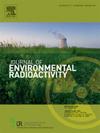将 222Rn 同位素作为监测水井功能的工具
IF 1.9
3区 环境科学与生态学
Q3 ENVIRONMENTAL SCIENCES
引用次数: 0
摘要
在撒哈拉以南非洲,手泵水井(HPWs)的特点是功能性差,建成后产量迅速下降。相当多的 HPW 可靠性低,水质差。监测性能变化是为 HPW 的预防性维护提供信息的先决条件。监测钻孔性能通常需要进行抽水测试,这在后勤方面要求很高。在这里,我们展示了天然存在的氡-222 同位素(222Rn)作为监测高压水井施工后性能的补充工具的适用性。我们测量了 32 个高压水井和含水层中的 222Rn 回收率(高压水井中的 222Rn 与含水层中的 222Rn 之比)。在测量 222Rn 之前,我们对高压水井进行了抽水和可靠性测试。高 压水井分为四个功能等级:a) 高产可靠;b) 高产但不可靠;c) 低产可靠;d) 低产不可靠。在第一类中,222Rn 的回收率很高,表明地下水在井中流动很快。这进一步表明井眼运行良好,没有滤网堵塞现象,而且井眼附近的含水层材料渗透性很高。第四类的 222Rn 回收率最低,这表明由于渗透率低、水位下降、滤网堵塞、初始设计不佳以及井眼内积水较多,井内水流缓慢。四个类别之间 222Rn 回收率的巨大差异表明,同位素示踪剂可以作为一种很有前途的独立工具,用于监测高压水井施工后性能的变化,而无需拆除高压水井进行检查。本文章由计算机程序翻译,如有差异,请以英文原文为准。
222Rn isotope as a tool for monitoring functionality of water wells
In Sub-Saharan Africa, hand pump-fitted water wells (HPWs) are characterized by poor functionality marked by rapid post-construction decline in yield. A substantial number of the HPWs show a low degree of reliability and poor water quality. Monitoring changes in performance is prerequisite to inform preventive maintenance of the HPWs. Borehole performance monitoring often requires a logistically demanding pumping test procedure. Here we demonstrate the applicability of a naturally occurring Radon-222 isotope (222Rn) as a complementary tool to monitor post-construction performance of HPWs. We measured 222Rn recovery (the ratio of 222Rn in the HPWs to that of the aquifer) in 32 HPWs and the host aquifers. Pumping and reliability tests have been conducted on the HPWs before taking the 222Rn measurements. The HPWs have been classified into four functionality classes a) high yield and reliable, b) high yield but unreliable, c) low yield and reliable and d) low yield and unreliable. In the first category, there is a high 222Rn recovery revealing a quick through flow of groundwater in the wells. This further demonstrates the healthy functioning of boreholes without screen clogging effects and a high permeability of the aquifer material in the vicinity of the well. The fourth category shows the lowest 222Rn recovery revealing a slow flow of water in the well owing to low permeability, declining water level, screen clogging, poor initial design and high water stagnation in the boreholes. The substantial difference in 222Rn recovery between the four categories reveals the isotopic tracer can be used as a promising independent tool to monitor post-construction changes in the performance of HPWs without the need for dismantling the HPWs for inspection.
求助全文
通过发布文献求助,成功后即可免费获取论文全文。
去求助
来源期刊

Journal of environmental radioactivity
环境科学-环境科学
CiteScore
4.70
自引率
13.00%
发文量
209
审稿时长
73 days
期刊介绍:
The Journal of Environmental Radioactivity provides a coherent international forum for publication of original research or review papers on any aspect of the occurrence of radioactivity in natural systems.
Relevant subject areas range from applications of environmental radionuclides as mechanistic or timescale tracers of natural processes to assessments of the radioecological or radiological effects of ambient radioactivity. Papers deal with naturally occurring nuclides or with those created and released by man through nuclear weapons manufacture and testing, energy production, fuel-cycle technology, etc. Reports on radioactivity in the oceans, sediments, rivers, lakes, groundwaters, soils, atmosphere and all divisions of the biosphere are welcomed, but these should not simply be of a monitoring nature unless the data are particularly innovative.
 求助内容:
求助内容: 应助结果提醒方式:
应助结果提醒方式:


